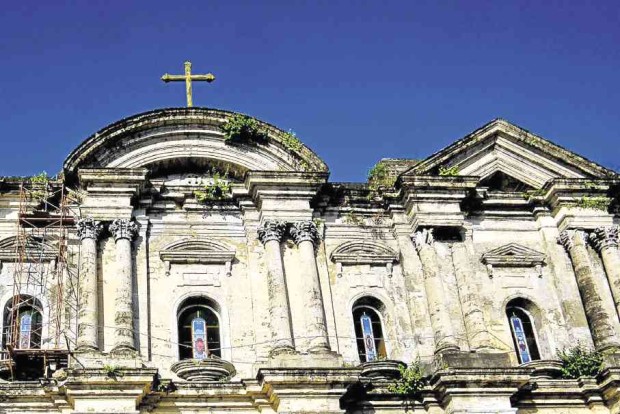Trauma counseling for quake victims

Sections of columns and moldings on the facade of the St. Martin de Tours Basilica in Taal town in Batangas fell off when the earthquake struck last week. —JOEL MATARO / CONTRIBUTOR
Residents of Mabini and Tingloy, the towns hardest hit by the series of earthquakes in Batangas province last week, suffered from trauma as they still refused to return to their homes due to continuing aftershocks.
According to Georgina Garcia, spokesperson for the Disaster Risk Reduction and Management Council (DRRMC) in Calabarzon (Cavite, Laguna, Batangas, Rizal, Quezon), disaster responders will start holding psychosocial therapy sessions on Wednesday in Mabini and Tingloy.
On Monday afternoon, the provincial government of Batangas declared Mabini, Tingloy and Batangas City under a state of calamity following widespread damage from the 5.6-magnitude earthquake that hit the province on Saturday.
Lito Castro, Batangas DRRMC chief, said this would allow the provincial government to allocate funds, specifically for buying tents and construction materials.
“During daytime, the residents would go home but would come back to the evacuation centers at night. They said they did not want to stay at home during the night and it’s not for us to stop them if that was a way to alleviate their worries,” Castro said.
Article continues after this advertisementAccording to latest figures from the regional DRRMC, 1,244 families (6,593 people) in Mabini either remained in evacuation sites or were staying with their relatives outside the town.
Article continues after this advertisementIn Tingloy, 3,122 families (7,394 people) were still in evacuation centers as of Monday.
About 3,000 evacuees remained in Batangas City and a number of families had yet to return to their houses in San Pascual, San Luis and Agoncillo towns.
“The aftershocks continued although [these were] not strong enough to be felt by the people,” Garcia said.
Community readiness
The series of earthquakes on April 4 and on April 8 had damaged houses, government buildings, churches and hospitals.
In Manila, Health Secretary Paulyn Jean Ubial said the Mabini General Hospital was closed after it sustained major damage following the earthquake.
According to Ubial, two other hospitals in the province, Batangas Medical Center and Bay District Hospital, have minor damage and are both open to the public.
The Department of Health (DOH), she said, was focused on providing medical needs in quake-hit areas.
“We allocated 50 tents for Batangas Medical Center and the [local government] hospital where patients evacuated,” Ubial said.
“And on standby, in case this will be needed, is P45.9 million worth of assorted supplies and medicines at the DOH warehouse and P13 million worth of supplies and assorted medicines ready for mobilization just in case we have other health emergencies in [Calabarzon],” Ubial said.
Ernie Martinez, general manager of Eagle Point Resort in Mabini town, said that while their guests on Saturday were sent home, there was no damage on the resort’s structures.
“[Sending away] guests was part of the precaution,” Martinez said in a telephone interview.
He said while another resort, Camp Netanya, was damaged, theirs continued to operate.
Prepared residents
Officials have not recorded any fatality. Six persons were reported to have suffered minor injuries.
“We just had a nationwide earthquake drill about two weeks ago and it seemed that the drills were still quite fresh in the minds of the residents,” Garcia noted.
She said the residents knew they should seek open areas in case of an earthquake, even without advisories from the local government.
The series of earthquakes that damaged at least two of the oldest churches in the Philippines failed to dampen the observation of Lent as churchgoers in Batangas province continued to flock to these places of worship.
In Taal town, hundreds of pilgrims from as far as the provinces of Iloilo, Laguna and Cavite came on Monday to pray at the St. Martin de Tours Basilica (Taal basilica).
The 161-year-old church was damaged anew by Saturday’s earthquake, with three large fragments of the church’s capitals (topmost portion of a column) falling off. A 5.4-magnitude earthquake that hit the province on April 4 also damaged its facade.
“We had just happily put back the facade (which was damaged by the April 4 earthquake). This time, the … capitals seemed to have been torn off the concrete posts,” said parish priest Alfredo Madlangbayan.
In Batangas City, the Minor Basilica of the Immaculate Conception was closed to the public after the earthquake damaged the church’s interiors.
Parish priest Aurelio Dimaapi said cracks were visible on the church’s adobe walls and its cornices.
But even so, Masses over the weekend pushed through without a significant decrease in the number of regular churchgoers, the priests said in separate telephone interviews on Monday.
Madlangbayan said the Taal Basilica’s main door was left open “only for the air to come in,” but churchgoers were directed to use the side doors.
Even the Palm Sunday Mass drew a large crowd, filling the Taal basilica “to the brim,” Madlangbayan said.
Dimaapi could not say when the basilica in Batangas City would open.
“We’re waiting for structural engineers to finish their assessment. But until then, we cannot say when (the basilica will be opened to the public),” he said.
The basilica was built in the 14th century, although the present structure is about 100 years old.
Safety
As a safety precaution, Dimaapi said Masses and activities for the Paschal Triduum (from Maundy Thursday to Easter Sunday) would be held at the Plaza Mabini, an open area across the basilica.
“We had plans (for Lent) that would not materialize as expected. But these will still push through,” Dimaapi said.
He said the recent earthquakes put Batangueños’ faith to test, perhaps a reminder to Catholics “to remember the sufferings of Jesus Christ.”
Madlangbayan, meanwhile, said they were also taking “corrective measures” to preserve the Taal basilica as long as time allows.
“This serves as a wake-up call,” he added. —WITH A REPORT FROM TINA G. SANTOS IN MANILA